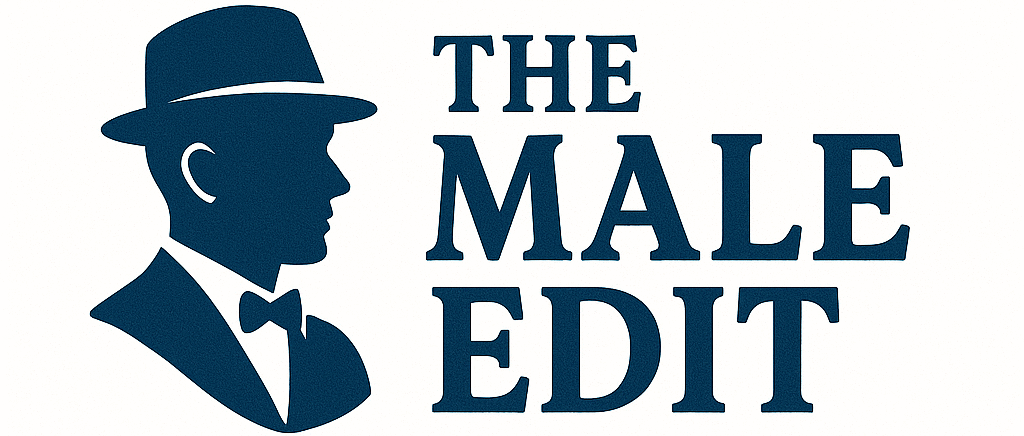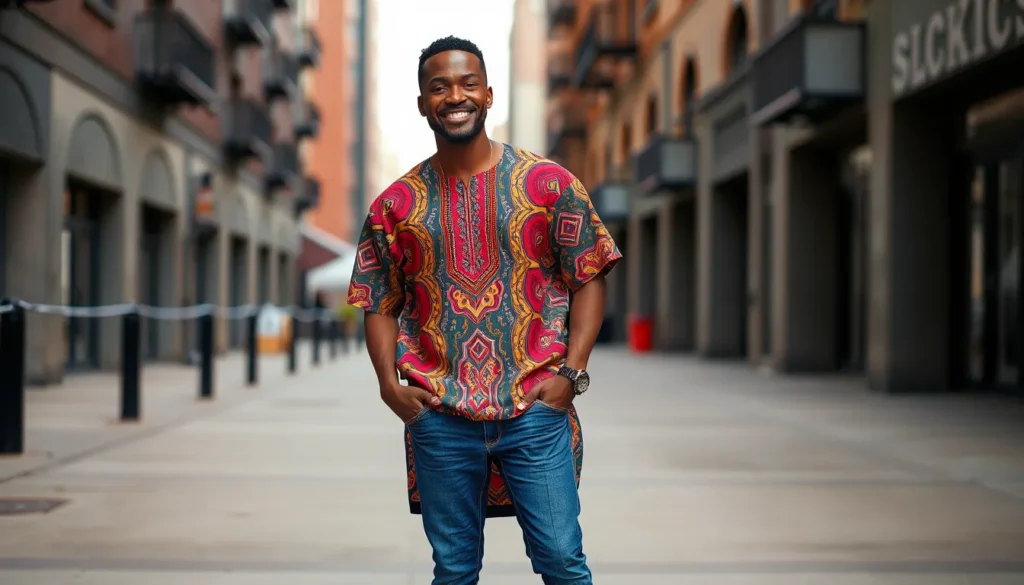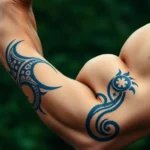African men’s fashion has evolved into a powerful blend of traditional heritage and contemporary style that’s capturing global attention. We’re witnessing a remarkable renaissance where ancient textiles like kente, dashiki, and ankara meet modern tailoring techniques to create stunning menswear that tells stories of culture and identity.
From boardrooms in New York to fashion weeks in Paris, African-inspired clothing for men is making bold statements that go far beyond mere fashion trends. We’ve seen how these vibrant patterns and rich fabrics transform everyday wardrobes into expressions of pride and sophistication.
Whether you’re looking to honor your roots or simply want to add distinctive flair to your style, African men’s clothing offers endless possibilities. We’ll explore how to incorporate these timeless pieces into your modern wardrobe while respecting their cultural significance and maximizing their visual impact.
Traditional African Dashiki: The Timeless Statement Piece for Modern Men
The dashiki stands as African menswear’s most recognizable and versatile garment, offering endless styling possibilities for the modern man’s wardrobe. This iconic piece transforms any outfit into a cultural statement while maintaining contemporary appeal.
Classic Dashiki Styling Tips for Everyday Wear
Fit selection makes or breaks your dashiki look, so we recommend choosing a size that allows comfortable movement without appearing oversized. Customized dashikis work best for professional settings, while loose-fitting versions suit casual weekend activities and social gatherings.
Accessorizing strategically elevates your dashiki from basic to brilliant through carefully chosen additions. Leather belts, wooden bracelets, and traditional African jewelry like cowrie shell necklaces complement the garment’s cultural significance. Simple leather sandals or clean white sneakers provide the perfect foundation for most dashiki outfits.
Layering techniques extend your dashiki’s versatility across different seasons and occasions. Lightweight cardigans or blazers work wonderfully over fitted dashikis during cooler months, while unbuttoned dashikis serve as excellent cover-ups over plain t-shirts during summer.
Occasion-appropriate styling ensures your dashiki always looks intentional and polished. We suggest wearing solid-colored dashikis to business casual events, while bold patterns work perfectly for cultural celebrations, festivals, and creative environments.
Choosing the Right Colors and Patterns for Your Skin Tone
Cool undertones pair beautifully with dashikis in blues, purples, and emerald greens that enhance natural skin radiance. Men with cool undertones should gravitate toward patterns featuring silver accents and geometric designs in jewel tones.
Warm undertones come alive with dashikis in rich oranges, deep reds, and golden yellows that complement natural skin warmth. Earth-toned patterns with bronze and copper accents create stunning combinations for men with warm undertones.
Neutral undertones offer the most flexibility, allowing you to experiment with virtually any dashiki color or pattern combination. We recommend starting with classic black and white geometric patterns before exploring bolder color combinations.
Pattern intensity should match your comfort level and the occasion’s formality requirements. Subtle patterns work best for professional environments, while bold, intricate designs make powerful statements at cultural events and social gatherings.
Pairing Dashikis with Contemporary Western Clothing
Denim combinations create effortless casual looks that blend African heritage with American style sensibilities. Dark wash jeans paired with fitted dashikis offer a balanced silhouette, while distressed denim works well with loose-fitting traditional styles.
Chino integration provides a polished alternative to jeans while maintaining the dashiki’s casual appeal. Khaki, navy, or olive chinos complement most dashiki colors and patterns without competing for visual attention.
Blazer layering transforms dashikis into sophisticated business casual attire suitable for modern workplaces. Neutral blazers in gray, navy, or beige allow dashiki patterns to shine while adding professional polish to your overall appearance.
Footwear selection significantly impacts your dashiki outfit’s overall vibe and appropriateness for different settings. Loafers and oxford shoes create refined looks, while boots add rugged appeal, and sneakers maintain casual comfort for everyday wear.
African Print Shirts: Vibrant Patterns That Command Attention
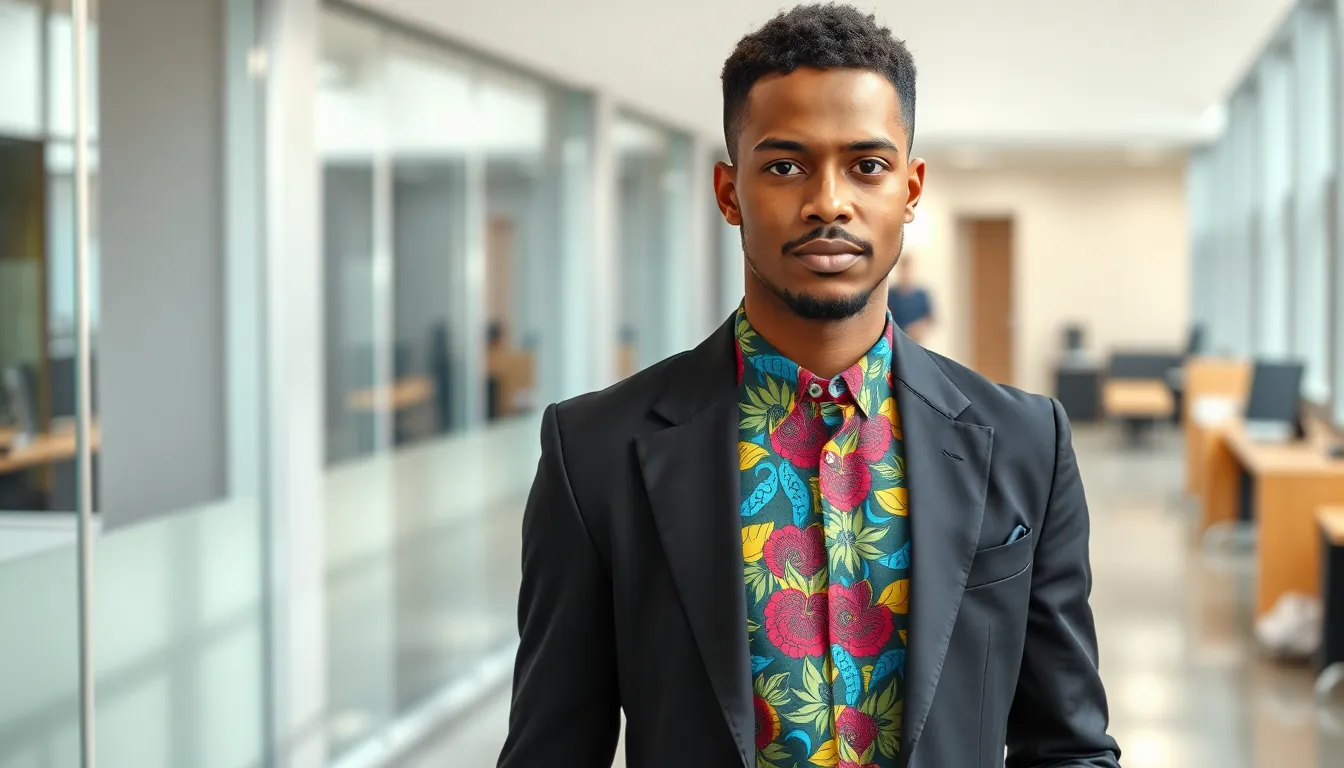
Moving beyond the classic dashiki, we explore another cornerstone of contemporary African menswear that’s making waves in fashion circles worldwide. African print shirts showcase the same cultural richness while offering even more versatility for modern styling needs.
Understanding Different African Print Styles and Origins
Ankara prints dominate the African print shirt industry with their bold wax-resist dyed patterns that originated in West Africa. These designs feature geometric motifs and symbolic elements that tell stories of cultural heritage and artistic expression.
Batik techniques create intricate hand-dyed patterns using traditional wax methods, prevalent across West and East African textile traditions. This ancient create produces unique designs where no two pieces are exactly alike, making each shirt a one-of-a-kind statement piece.
Kente patterns bring Ghanaian weaving traditions to modern shirt designs, featuring multi-colored symbolic motifs historically associated with royalty and high status. Contemporary designers adapt these traditional patterns into shirt formats while preserving their cultural significance.
Dashiki-inspired shirt designs maintain the loose, colorful aesthetic of traditional garments while incorporating structured tailoring for contemporary wear. These pieces bridge the gap between ceremonial clothing and everyday fashion.
How to Style African Print Shirts for Professional Settings
Choose darker, muted prints when selecting African print shirts for office environments, as subtle design elements maintain professionalism while showcasing cultural pride. These sophisticated options work particularly well in creative industries and multicultural workplaces.
Pair with solid-colored blazers to balance the boldness of African prints, creating polished looks suitable for formal business settings. Navy, charcoal, or black blazers provide elegant contrast while allowing the print to serve as a tasteful accent.
Incorporate African prints through accessories like ties or pocket squares for conservative professional environments where full print shirts might be too bold. This approach introduces cultural elements subtly while maintaining traditional business dress codes.
Select well-customized fits that follow contemporary shirt silhouettes, ensuring African print shirts look intentional rather than costume-like in professional settings. Proper tailoring elevates these pieces from casual wear to sophisticated business attire.
Mixing and Matching African Print Shirts with Solid Colors
Black, white, and navy serve as perfect neutral companions for vibrant African prints, allowing the patterns to take center stage without competing elements. These classic colors work with virtually any African print design or color palette.
Beige and neutral tones create sophisticated combinations that highlight the artistry of African textile traditions while maintaining wearability for various occasions. Earth tones particularly complement warm-colored prints featuring oranges, reds, and golds.
Denim provides casual balance when paired with bright African print shirts, creating effortlessly stylish looks perfect for weekend activities or relaxed social gatherings. This combination works especially well for younger men embracing cultural fashion trends.
Strategic color picking from within the print itself helps create cohesive outfits where solid pieces complement rather than clash with the African patterns. Retailers like D’iyanu and Africa Imports offer guidance on coordinating pieces that work harmoniously together.
Kente Cloth Accessories: Adding Authentic African Flair to Any Outfit

Kente cloth transforms any wardrobe with its vibrant patterns and deep cultural significance rooted in Ghanaian tradition. We’ve discovered that incorporating these colorful accessories creates stunning visual impact while honoring African heritage in both professional and casual settings.
Incorporating Kente Ties and Pocket Squares into Business Attire
Kente ties elevate business attire by blending professional aesthetics with authentic African cultural elements. Professional men increasingly choose these bold accessories to make subtle yet powerful statements about their identity and heritage in corporate environments.
Pairing a Kente tie with a crisp white dress shirt creates an immediate focal point that commands attention during meetings and presentations. We recommend selecting ties with darker background colors like deep blues or rich burgundies to maintain workplace appropriateness while showcasing the intricate geometric patterns.
Pocket squares offer a more understated approach to incorporating Kente into business looks. These smaller accessories provide just enough cultural flair without overwhelming conservative office dress codes, making them perfect for formal and semi-formal professional settings.
Color coordination becomes essential when wearing Kente business accessories. We suggest choosing solid colored suits in navy, charcoal, or black to let the vibrant Kente patterns shine as the outfit’s centerpiece.
Kente Stoles and Scarves for Formal Occasions
Kente stoles serve as powerful symbols of heritage and status during weddings, graduations, and cultural celebrations. These flowing accessories drape elegantly over formal attire, creating dramatic visual impact that honors traditional African craftsmanship.
Wedding ceremonies particularly benefit from Kente stole incorporation, as the rich symbolism adds deeper meaning to these milestone moments. Grooms often choose stoles that match their partner’s Kente accessories, creating cohesive looks that celebrate their shared cultural identity.
Graduation events showcase Kente stoles as badges of academic achievement intertwined with cultural pride. We’ve observed that these accessories help graduates stand out in ceremonies while connecting their educational success to their African roots.
Ceremonial occasions demand authentic Kente pieces rather than printed imitations to properly honor the fabric’s sacred significance. Traditional weavers create each authentic stole with exact color combinations that carry distinct meanings about wisdom, strength, and prosperity.
Modern Kente-Inspired Accessories for Casual Wear
Contemporary fashion adapts Kente patterns into everyday accessories that maintain cultural significance while offering versatile styling options. Casual Kente accessories include baseball caps, backpacks, and wristbands that incorporate traditional patterns into modern designs.
Sneaker collaborations now feature Kente-inspired colorways and patterns, allowing men to showcase African heritage through their footwear choices. These shoes pair excellently with jeans and casual button-down shirts for weekend outings and social gatherings.
Watch bands and bracelets with Kente patterns provide subtle ways to incorporate African elements into daily looks. We find these smaller accessories work particularly well for men who prefer minimalist styling but still want to express their cultural connections.
Belt designs featuring Kente patterns offer another avenue for casual African fashion expression. These accessories work effectively with both dark and light denim, creating interesting visual contrasts that draw attention to the waistline while celebrating traditional craftsmanship.
African-Inspired Suits and Formal Wear: Elevating Professional Style
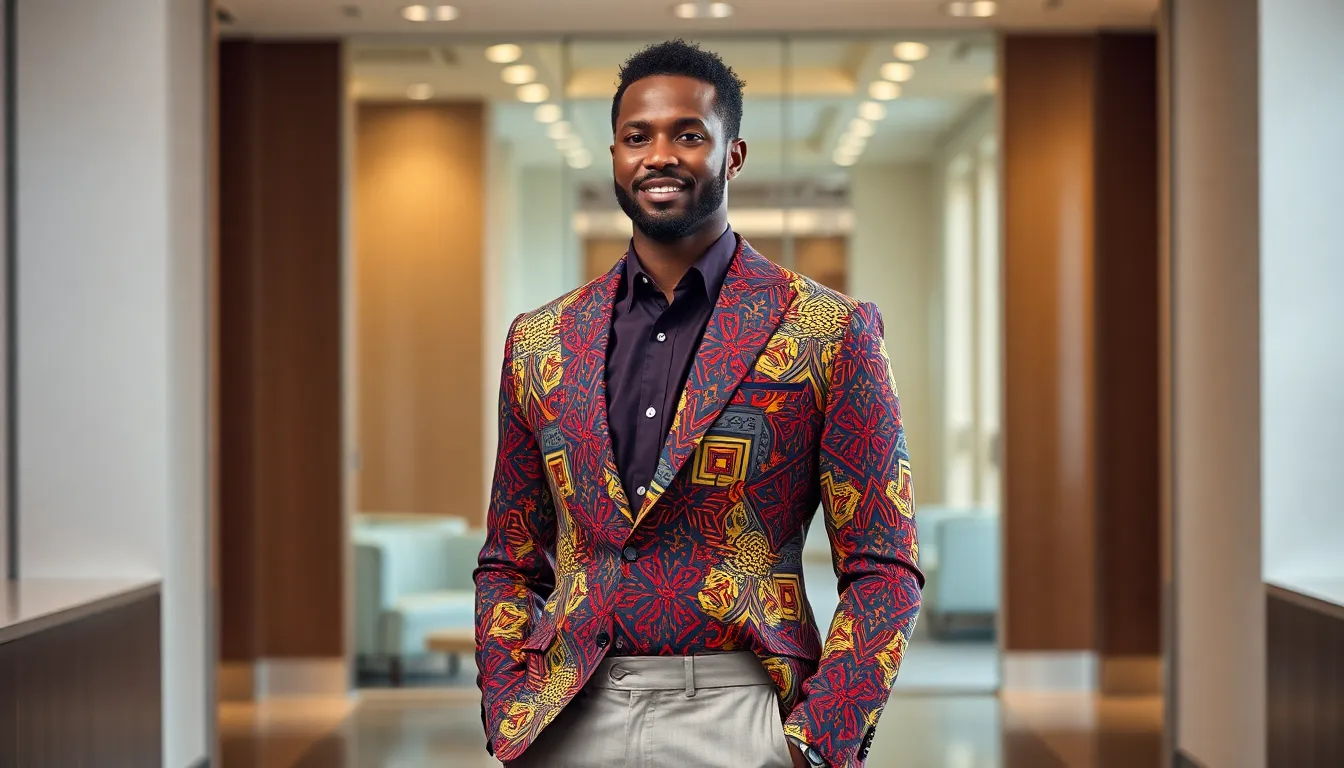
Professional menswear transforms dramatically when we incorporate African-inspired elements into formal suiting. This sophisticated approach blends traditional African fabrics like Ankara, Dashiki, and geometric patterns with contemporary tailoring techniques.
Custom Customized African Print Blazers and Suit Jackets
Custom customized blazers crafted from African fabrics create powerful statement pieces that maintain professional sophistication. We see Ankara and Kente fabrics expertly customized into modern silhouettes that fit contemporary dress codes while celebrating cultural heritage.
Bold colors and intricate patterns define these custom pieces, transforming conventional blazers into conversation starters. Tailors work with vibrant African prints to create blazers that feature structured shoulders, clean lines, and precise fits that rival traditional formal wear.
Statement blazers serve as focal points in professional wardrobes, allowing men to express cultural pride without sacrificing business appropriate aesthetics. These pieces often incorporate gold threads, geometric designs, and rich color palettes that elevate any formal ensemble.
Modern silhouettes ensure these African print blazers work seamlessly in corporate environments. We recommend choosing fabrics with smaller, more subdued patterns for conservative office settings while reserving bold, large scale prints for creative industries and special events.
African-Inspired Wedding and Special Occasion Attire
Complete African groom suits showcase the full potential of traditional fabrics in formal celebration wear. These ensembles typically include matching blazers, trousers, and accessories that create cohesive, culturally important looks for weddings and ceremonial occasions.
Long shirts and customized trousers form the foundation of many African-inspired wedding outfits, offering elegant alternatives to Western formal wear. We often see these pieces crafted from luxurious fabrics like silk blended with traditional African prints.
Matching accessories complete the special occasion look, including bow ties, pocket squares, and cufflinks that coordinate with the main garments. These details ensure the entire ensemble feels intentional and polished for important celebrations.
Cultural identity takes center stage in wedding attire while maintaining the formal dress code requirements. Grooms can honor their heritage through fabric choices, color schemes, and traditional design elements that reflect family history and personal values.
Mixing African Fabrics with Traditional Suit Components
Hybrid tailoring approaches create sophisticated looks by combining African fabrics with classic suit elements. We see this trend in blazers that feature African print lapels paired with solid colored bodies, or traditional suits with African fabric accents on collars and cuffs.
Panel combinations offer subtle ways to incorporate African heritage into formal wear, such as African print vest panels under solid blazers or patterned pocket squares that complement neutral suits. These approaches balance cultural expression with professional requirements.
Mix and match strategies allow men to gradually incorporate African elements into existing wardrobes. Pairing African print blazers with traditional solid colored trousers creates balanced looks that feel both contemporary and culturally connected.
Contemporary design principles guide these fabric combinations, ensuring that African elements enhance rather than overwhelm formal silhouettes. Successful mixing requires attention to color harmony, pattern scale, and fabric weight to achieve polished results suitable for professional environments.
Contemporary African Streetwear: Modern Fashion Meets Cultural Heritage
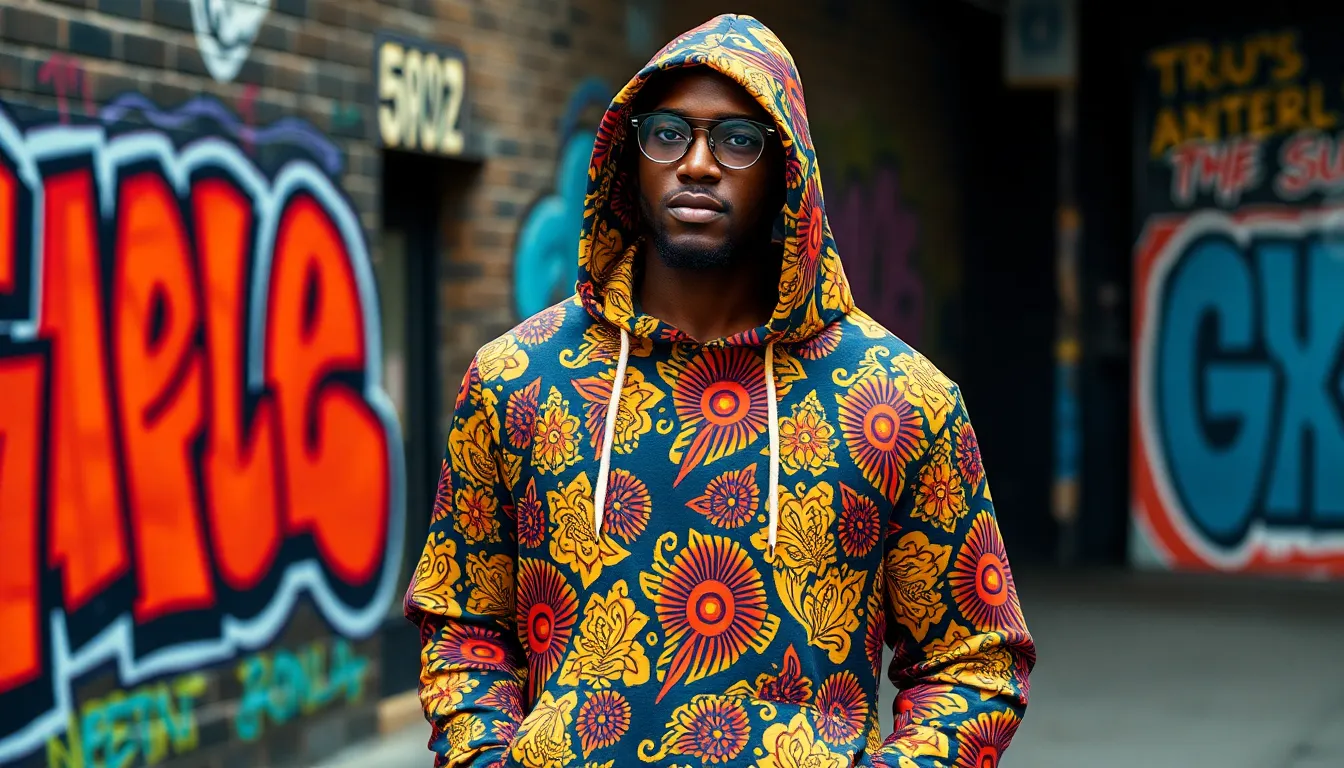
Contemporary African streetwear represents a ever-changing fusion where traditional prints and fabrics meet modern silhouettes, creating a unique aesthetic that celebrates cultural heritage while embracing urban fashion trends. This movement transforms bold African prints like Ankara into oversized tunics and flowing kaftans, establishing gender-neutral designs that offer versatility and self-expression.
African-Inspired Hoodies and Casual Tops
African-inspired hoodies revolutionize casual wear by incorporating traditional prints and intricate embroidery into comfortable, everyday pieces. We’re seeing designers blend modern cuts with vibrant Ankara patterns, creating hoodies that make cultural statements while maintaining street style credibility. Embroidered details featuring traditional African motifs add sophisticated touches to basic pullover designs, transforming simple hoodies into conversation starters.
Casual tops embrace this same philosophy, featuring bold geometric patterns and earth-tone color palettes that reflect African textile traditions. Designers often incorporate elements like mud cloth patterns from Mali or Kente-inspired stripes into fitted tees and long-sleeve shirts. These pieces work seamlessly with jeans or joggers, allowing us to express cultural pride in relaxed settings.
Urban African Fashion Brands Leading the Movement
Urban African fashion brands are spearheading this cultural renaissance by combining traditional fabrics with contemporary design principles. These brands typically source authentic African textiles and reimagine them through modern tailoring techniques, creating pieces that resonate with both African diaspora communities and fashion-forward consumers globally.
Brand innovation focuses on creating versatile pieces that transition from street to formal settings, using traditional prints in unexpected applications. Many of these companies prioritize sustainable practices by working directly with African textile producers, ensuring authenticity while supporting local economies. Their designs often feature adjustable elements and unisex styling, reflecting the inclusive nature of contemporary streetwear culture.
Street Style Tips for Incorporating African Elements
Use bold prints strategically by selecting one African-inspired piece as your outfit’s focal point, then building around it with neutral colors. Ankara print joggers pair perfectly with solid-colored hoodies, while African-print bomber jackets elevate basic tee and jean combinations.
Add cultural accents through accessories like beaded bracelets, leather bags with traditional patterns, or caps featuring African textile details. These smaller elements allow us to incorporate heritage without overwhelming our overall look.
Mix modern and traditional silhouettes by combining flowing kaftans with fitted jeans or pairing structured blazers with traditional print pants. This approach creates visual interest while maintaining contemporary appeal.
Layer thoughtfully using African-inspired pieces as statement layers over basic foundations. A vibrant African print cardigan over a simple white tee creates depth while keeping the cultural element prominent.
Choose complementary colors by selecting African prints with colors that enhance your skin tone, then repeating those hues in your accessories or footwear to create cohesive styling.
Traditional African Robes and Caftans: Comfort Meets Cultural Pride
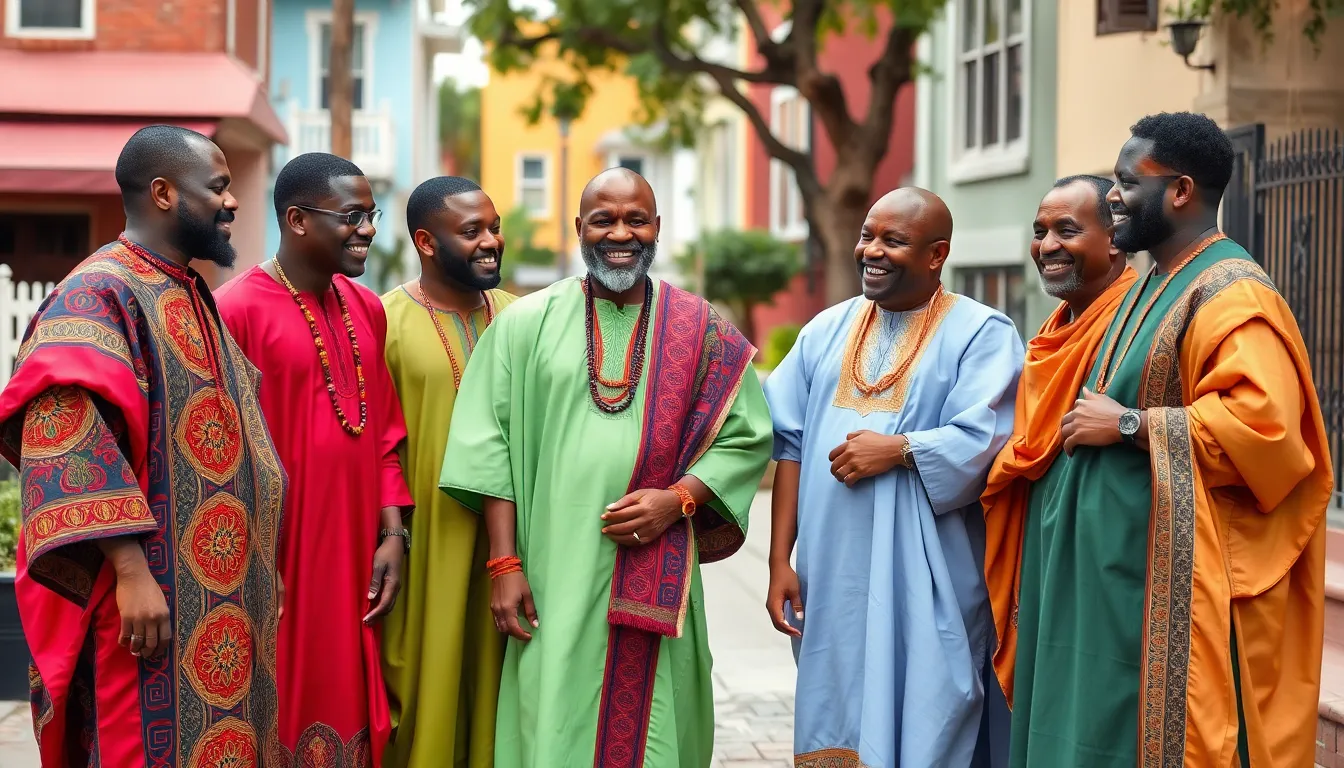
Moving beyond contemporary streetwear, we discover the timeless elegance of traditional African robes that seamlessly blend cultural heritage with modern comfort. These flowing garments represent the pinnacle of African menswear, offering both practical benefits and deep cultural significance through their distinctive designs and craftsmanship.
Agbada Robes for Special Occasions and Ceremonies
Agbada robes command attention at life’s most important celebrations through their flowing wide sleeves and ceremonial grandeur. Reserved for special occasions such as weddings, naming ceremonies, and religious events, these magnificent garments symbolize status and respect within West African cultures. We see their true artistry in the high quality fabrics adorned with gold or silver thread embroidery that catches light beautifully during formal gatherings.
Complete agbada ensembles include matching pants and traditional caps, creating a harmonious look that speaks to cultural identity and sophistication. The robe’s dramatic silhouette transforms the wearer into a figure of elegance and dignity, making it the preferred choice for grooms, dignitaries, and honored guests at important ceremonies.
Craftsmanship in agbada creation involves meticulous attention to detail and traditional tailoring techniques. Master tailors often spend weeks creating a single garment, ensuring that the intricate embroidery patterns tell stories of heritage and family lineage through their symbolic designs.
Everyday Caftan Styling for Comfort and Style
Everyday caftans offer men the perfect balance of casual comfort and cultural expression for daily wear. These loose fitting garments feature simple lines and breathable cotton fabrics that provide freedom of movement while maintaining a polished appearance throughout busy days. We appreciate how caftans adapt to various settings, from morning coffee meetings to evening social gatherings.
Dashikis complement caftans as colorful alternatives that embrace both traditional African communities and diaspora fashion preferences. Their vibrant patterns and comfortable fit make them ideal choices for semi formal occasions where cultural pride meets contemporary style sensibilities.
Styling versatility allows caftans to transition seamlessly from home to office environments. Neutral colored caftans pair beautifully with dress shoes for professional settings, while patterned versions work perfectly with sandals for weekend relaxation and social events.
Regional Variations in African Robe Styles
Regional diversity across Africa creates distinct robe styles that reflect local cultural influences and climate considerations. Each variation incorporates unique fabrics, colors, and embroidery techniques that represent the rich heritage spanning the entire continent.
| Region | Robe Style | Key Features | Primary Countries |
|---|---|---|---|
| West Africa | Agbada | Wide sleeves, heavy embroidery | Nigeria, Senegal, Mali |
| North Africa | Djellaba/Gandoura | Hooded, ankle length | Morocco, Algeria, Tunisia |
| East Africa | Kanzu | White/cream, formal tailoring | Uganda, Tanzania |
| Southern Africa | Shweshwe Styles | Patterned fabrics, fitted cuts | South Africa, Botswana |
West African agbada robes showcase the most elaborate embroidery work found anywhere on the continent. Their wide sleeves require exact fabric weights and tailoring expertise that has been passed down through generations of skilled craftsmen.
North African djellaba and gandoura styles prioritize practicality with their hooded designs. Common throughout Maghreb countries, these robes protect wearers from desert winds while maintaining the flowing elegance that characterizes traditional African menswear.
East African kanzu robes emphasize simplicity through their clean white or cream coloring. Primarily worn in countries such as Tanzania and Uganda, these ankle length garments represent purity and spiritual significance in many ceremonial contexts.
Southern African variations incorporate distinctive patterned fabrics like Shweshwe into their construction. Different tailoring styles reflect local cultural influences while maintaining the comfort and dignity that define traditional African robes across all regions.
African Jewelry and Accessories: Completing Your Cultural Look

Jewelry transforms African menswear from beautiful garments into complete cultural expressions. Accessories add layers of meaning and authenticity to traditional and contemporary African outfits.
Traditional African Beadwork and Necklaces for Men
Beadwork represents one of Africa’s most important jewelry traditions for men, often symbolizing status, tribal affiliation, and personal achievements. Colorful bead necklaces crafted from natural materials like bone, wood, and metals express cultural identity and pride through their intricate designs.
Patterns vary dramatically across different African regions, with each area maintaining unique symbolic meanings and traditional techniques. Maasai warriors wear red and white beaded necklaces that represent bravery and purity, while Zulu men don black and gold combinations that signify wisdom and strength.
Materials used in traditional beadwork include seeds, shells, stones, and hand-carved wooden elements that connect the wearer to nature and ancestral traditions. Glass beads introduced through trade routes have become integral to many contemporary African jewelry designs while maintaining cultural authenticity.
Lengths and layering techniques create visual impact when multiple necklaces combine to form statement pieces for special occasions. Single-strand designs work perfectly for everyday wear, allowing men to incorporate African heritage into modern wardrobes without overwhelming their overall look.
African-Inspired Watches and Bracelets
Contemporary African-inspired timepieces blend traditional motifs with modern craftsmanship, creating accessories that are both stylish and culturally meaningful. Watch faces often feature tribal patterns, symbolic colors, or materials that represent exact ethnic groups and their heritage.
Leather straps incorporate authentic African patterns such as mud cloth designs from Mali or geometric patterns from various West African cultures. Metal bands showcase traditional engravings and symbols that carry spiritual significance while maintaining contemporary appeal for daily wear.
Bracelets combine modern materials with traditional elements, using silver, brass, and copper alongside natural materials like wood and bone. Cuff-style bracelets feature hand-carved patterns that tell stories or represent family lineages, making each piece unique and personal.
Stackable bracelet sets allow men to customize their look by mixing different textures, colors, and symbolic elements. Combining leather, metal, and beaded bracelets creates layered effects that complement both casual and formal African-inspired outfits.
Cultural Significance of Different African Jewelry Styles
Different African jewelry styles carry deep cultural meanings that extend beyond aesthetic appeal to represent social status, spiritual beliefs, and important life transitions. Understanding these significances helps men choose accessories that honor African heritage while expressing personal identity.
Maasai bead necklaces communicate exact information about marital status and age sets within the community structure. Married men wear different color combinations than single men, while elders display patterns that reflect their wisdom and experience.
Fulani jewelry traditions include intricate earrings and bracelets that indicate family lineage and social position within the pastoral communities. Gold and silver pieces often pass down through generations, carrying ancestral blessings and family history.
West African cultures use jewelry to mark rites of passage, with exact pieces worn during coming-of-age ceremonies, weddings, and other important life events. Wearing these accessories connects modern men to centuries-old traditions while showcasing their cultural pride.
Regional variations reflect local beliefs and practices, from Ethiopian crosses that represent Christian faith to North African amulets that provide spiritual protection. Each style contributes to the rich diversity of African men’s jewelry traditions and their contemporary interpretations.
Shopping Guide: Where to Find Authentic African Clothing for Men

Finding quality African menswear requires knowing where to shop and what to look for. We’ve researched the best sources to help you build an authentic African wardrobe that honors cultural heritage while meeting modern style needs.
Online Retailers Specializing in African Men’s Fashion
D’iyanu offers stylish African print clothing with a modern aesthetic, featuring dashiki tops, print sweaters, and hoodies that blend traditional patterns with contemporary cuts. Their collection emphasizes versatility for men seeking to incorporate African elements into everyday wear.
Afrilege provides an extensive selection including African print shirts, fitted vests, printed blazers, bow ties, and sandals. Kente print blazers and coordinated two-piece outfits showcase their commitment to both traditional craftsmanship and modern tailoring standards.
Africa Imports focuses on wholesale African men’s clothing with fast US shipping, offering dashikis, shirts, t-shirts, coats, sweatshirts, and complete sets suitable for special occasions and daily wear. Their emphasis on supporting African producers ensures authenticity while maintaining competitive pricing.
Continent Clothing features ethically made men’s African clothing handcrafted by artisans in The Gambia. Fair trade practices and traditional craftsmanship define their approach to sustainable fashion.
AfricanClothing.us sells apparel, footwear, and textiles labeled “Made in Africa” from established and emerging fashion designers. Their curation process ensures both authenticity and quality across their entire collection.
Supporting African Designers and Artisans
Purchasing from specialized retailers directly supports African designers and artisans while preserving cultural heritage. Economic opportunities within African communities expand when consumers choose ethically sourced and handmade garments over mass-produced alternatives.
Fair compensation for artisans helps sustain traditional textile arts that might otherwise disappear. Supporting these creators ensures cultural knowledge passes to future generations while providing sustainable livelihoods.
Community impact extends beyond individual purchases when retailers partner directly with African producers. These relationships foster long-term economic development and cultural preservation across the continent.
What to Look for When Buying Quality African Clothing
Authenticity requires choosing clothing labeled “Made in Africa” or sold by retailers partnering directly with African designers and artisans. Genuine pieces carry cultural significance that mass-produced imitations cannot replicate.
Material Quality determines durability and comfort through high-quality cotton, Ankara, Kente, or other traditional fabrics. Premium materials maintain their appearance and feel after repeated wear and washing.
Craftsmanship shows in well-stitched seams, detailed prints, and accurate cultural patterns indicating skilled handiwork. Examine construction quality to ensure your investment will last for years.
Fit and Style considerations include whether you prefer traditional loose-fitting dashikis or modern customized African print suits. Choose pieces that match your lifestyle and personal aesthetic preferences.
Ethical Production support comes from choosing brands promoting fair trade and ethical labor practices. These choices contribute to the African fashion industry’s long-term sustainability while ensuring workers receive fair treatment.
Conclusion
African menswear offers us an incredible opportunity to embrace both style and cultural heritage. We’ve explored how traditional pieces like dashikis kente accessories and contemporary streetwear can seamlessly integrate into our modern wardrobes.
The key lies in understanding authenticity and quality when we’re shopping for these pieces. By supporting African designers and artisans we’re not just building a distinctive wardrobe—we’re participating in preserving rich cultural traditions.
Whether we’re incorporating subtle kente accents into our business attire or making bold statements with vibrant prints African fashion empowers us to express our identity while celebrating centuries of craftsmanship and artistry.
Frequently Asked Questions
What is African menswear and why is it gaining popularity?
African menswear blends traditional heritage with contemporary style, featuring textiles like kente, dashiki, and ankara combined with modern tailoring. It’s gaining global recognition because it allows men to express cultural identity while maintaining sophistication in both corporate and casual settings, creating unique fashion statements that stand out.
How do I style a dashiki for modern everyday wear?
Choose a well-fitted dashiki and pair it with contemporary pieces like denim, chinos, or blazers. Focus on proper fit, complementary colors for your skin tone, and appropriate footwear. Layer with jackets for cooler weather and keep accessories minimal to let the dashiki remain the focal point.
What are the different types of African print shirts available?
The main types include ankara (West African wax prints), batik (Indonesian-influenced designs), and kente (Ghanaian geometric patterns). Each style has unique origins and cultural significance, offering vibrant patterns and versatility for both professional and casual styling needs.
How can I incorporate kente accessories into business attire?
Use kente ties and pocket squares with solid-colored suits to make subtle cultural statements. Choose darker, more muted kente patterns for professional settings and ensure proper color coordination. These accessories elevate business attire while maintaining workplace appropriateness and showcasing cultural pride.
What is contemporary African streetwear?
Contemporary African streetwear fuses traditional prints with modern urban silhouettes, including hoodies, casual tops, and accessories featuring African-inspired embroidery and patterns. Urban African fashion brands lead this movement, prioritizing sustainability and authenticity while reimagining traditional fabrics through contemporary design principles.
What are traditional African robes and when should they be worn?
Traditional African robes include agbada (West African ceremonial robes), everyday caftans, djellaba (North African), kanzu (East African), and shweshwe styles (Southern African). Agbada robes are reserved for special occasions and symbolize status, while caftans offer comfortable everyday wear suitable for various settings.
How do I choose authentic African jewelry and accessories?
Look for pieces that reflect traditional beadwork, tribal significance, and cultural meanings. Choose jewelry that represents status, spiritual beliefs, or life transitions appropriately. Consider contemporary African-inspired watches and bracelets that blend traditional motifs with modern craftsmanship while respecting cultural heritage.
Where can I buy authentic African men’s clothing?
Shop from reputable online retailers like D’iyanu, Afrilege, and Africa Imports that specialize in African menswear. Support African designers and artisans to preserve cultural heritage. Consider authenticity, material quality, craftsmanship, proper fit, and ethical production practices when making purchases.
How do I ensure I’m wearing African clothing respectfully?
Research the cultural significance of pieces before wearing them, especially for ceremonial items like kente stoles or agbada robes. Purchase authentic pieces from African designers and artisans rather than mass-produced imitations. Understand the meanings behind patterns and symbols to honor the heritage appropriately.
What should I consider when building an African-inspired wardrobe?
Focus on versatile pieces that can be mixed with contemporary Western clothing. Start with basics like dashikis and African print shirts, then add accessories like kente ties. Consider your lifestyle needs, from professional settings to casual wear, and invest in quality, authentic pieces that reflect cultural heritage respectfully.
